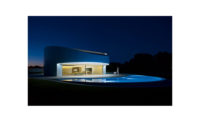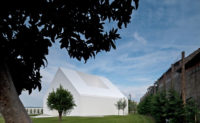The lively streets and cafés that make a city like Seville, Spain, so attractive to visitors have a hidden counterpart in the tiny, dark, and decaying apartments that form much of the housing stock in older districts. Overbuilding has crowded out what appears to have been a more relaxed, amiable city, still visible in a few privileged corners, where houses open around plant-filled patios and lush gardens.
Additional Information:Jump to People/Products
Architects Harald Schönegger and Inmaculada González sought to recover this ideal Seville, with its combination of urbanity and livability, when they built a home for themselves and their two college-age children on a narrow street in the heart of the historic center.
While Schönegger, a native of northern Italy’s German-speaking provinces, and González, who is Spanish, maintain separate professional careers, their design reflects their modernist vision of urban living. Schönegger confesses that Mies van der Rohe, particularly his Court House projects of the 1930s, was indeed an important point of reference, with glazed volumes of soaring open spaces set between walled courts filled with trees and plants.
The raw shell for their project is typical of the city’s older dwellings. The modest three-story house dates to the late 18th century, but was subsequently converted into apartments, its open spaces obstructed by a hodgepodge of careless additions. Nevertheless, the parcel had “generous proportions,” according to Schönegger, including 12-foothigh ceilings on the first two floors. The architects restored the original facade, with its characteristic unglazed windows—small hinged doors open in the heavy wood shutters to let in light and air. They kept the first structural bay, as mandated by local preservation laws, but pulled down the rest and started over.
According to Schönegger, their goal was “create an interior landscape, pleasant and green.” Gingko trees in the two cobblestone-paved courtyards, climbing ivy, and a plant-covered terrace and rooftop garden soften the new structure inserted between the open spaces. The architects also brought controlled natural light into the house with walls of floor-to-ceiling glass, including operable sections to assure crossventilation.
In the entry court, the architects removed the back wall of the original structure to enclose it almost entirely in glass, using transverse beams to support the restored wood joists of the floors and roof. As a result, views from the second-floor kitchen and dining area at the front of the building extend across the entire parcel, through the entry court and the generous living area, beyond to the trees and ivy-covered walls at the back. The couple describe the composition as “two crisp volumes containing only air and light.”
Important details add to the design’s atmosphere of ethereal spaciousness, particularly the tall spiral staircase of black steel plate, crafted by Jorge Vázquez Consuegra. Rather than branching off a central pole, the stair winds exquisitely around a void, supported by the twisting steel flange of the banister. The minimalist stainless-steel cube of the island kitchen in the ground-floor guest suite offers another elegantly sculptural element, as does the longer rectangular one on the main level above.
Other subtle refinements include recessed windows for solar protection and discreet sliding shutters in the bedrooms. The raised, planted terrace on the roof of the living room overlooking the entry court strikes a particularly felicitous note: set in front of the master bedroom, its thick green foliage open to the sky can be seen from the large window in the bath’s walk-in shower.
Despite its interior warmth and charm, the house is a forbidding presence on the street, a passageway too narrow for cars near the Feria Market. The architects painted the entire facade in matte white, including balcony railings and the elaborate window shutters.
Schönegger explains that their intention was to emphasize its proportions, but the result, with its blind windows, is rather austere, as if they were trying to make the building invisible, and suggests a lack of comfort or security in a neighborhood currently undergoing gentrification. However, when the wide front door opens to reveal the courtyards beyond, with their greenery and dappled light, the contrast is dramatic.
Like Mies’s Court House projects, Schönegger and González’s residence provides an engaging meditation on the attractions and anxieties of city living. And it offers a more sensitive alternative to the old modernist obsession with curing the ills of the overcrowded city through wholesale demolition.
PeopleArchitect: Harald Schönegger and Immaculada González
Engineers: Tedesco (structural, m/e/p)
General Contractor: Eric Desmons Construcciones
Client: Harald Schönegger and Immaculada González
Size: 4,200 square feet
Cost: $520,000
Completion date: January 2015
architecture — Jean-François
Milou, lead architect; Wenmin Ho,
Thomas Rouyrre, architectural
team managers; Charmaine Boh,
Janis Goh, Trung Thanh Nguyen,
Jason Tan, Jiarong Goh, May Leong,
Eudora Tan, architectural designer
|
ProductsStructural system Concrete, steel and wood frame Prestressed concrete slab: Forjados Tor S.L. Malaga, www.forjadostor.com/es
Exterior cladding Masonry: Eric Desmons Construcciones Metal Panels: Talleres Vazquez S.A., www.talleresvazquez.com Metal/glass curtain wall: Talleres Vazquez S.A., www.talleresvazquez.com Moisture barrier: Danosa, Derivados Asfálticos Normalizados S.A., www.danosa.com Curtain wall: Talleres Vazquez S.A., www.talleresvazquez.com
Roofing Tile/shingles: Original of the historic house, ceramic, handmade
Windows Metal frame: Talleres Vazquez S.A., www.talleresvazquez.com
Glazing Glass: Astiglass S.L., www.astiglass.com
Doors Metal doors: Talleres Vazquez S.A., www.talleresvazquez.com Wood doors: Vercar S.L. Sliding doors: Talleres Vazquez S.A., www.talleresvazquez.com
Interior finishes Cabinetwork and custom woodwork: Vercar S.L. Wall coverings: Placo Saint Gobain, www.placo.es Paneling: Vercar S.L, www.vercar.es Special interior finishes unique to this project: Wooden floor: Alejandro Reina S.L., www.alejandroreina.com |
















